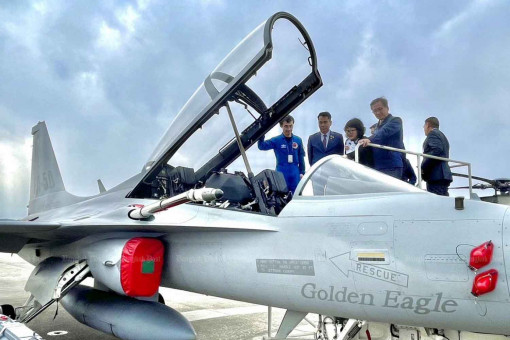Air force plans to spend B19bn on new aircraft

Seoul: Korea Aerospace Industries (KAI) has proposed to sell FA50 light fighters to the Royal Thai Air Force (RTAF) which plans to spend 19 billion baht in the next fiscal year to procure new fighter jets, according to a source in the Defence Ministry.
The proposal was floated by Kang Goo-young, CEO of KAI, during Defence Minister Sutin Klungsang’s visit to South Korea which ended on Saturday.
Mr Sutin, accompanied by defence permanent secretary Gen Sanitchanok Sangkhachan, was invited by South Korea’s Defence Ministry to observe the last two of the Korean-made T-50 advanced trainer jets to be delivered to the RTAF in August.
His delegation travelled by helicopter arranged by the host to KAI’s facility in Sacheon.
In 2015, the RTAF procured a total of 8 T-50 advanced trainer jets and six FA50 light fighters from KAI with the aircraft gradually delivered and put into commission at the Nakhon Sawan-based Wing 4 since 2018.
In a media interview, Mr Kang Goo-young said the company’s FA50 is a multi-role fighter that can match the air combat capabilities of US-made F16 fighter jets but at almost half the cost and lower maintenance expense.
The KF-21, also developed by KAI, costs only US$80 million (2.9 billion baht) with maintenance cost of $14,000 per flight hour, he said.
“We’re ready to make a proposal to the RTAF to consider our fighter jets which are cheaper and worthy of their cost,” Mr Kang Goo-young.
The RTAF plans to decommission 102 Squadron’s old F16s at Wing 1 and replace them with 12 new fighter jets.
The initial phase requires 19 billion baht in the upcoming 2025 fiscal year to purchase the first four aircraft, according to the air force’s White Paper.
Air force commander, ACM Punpakdee Pattanakul, said last week the jet procurement scheme was expected to be tabled to the cabinet on April 2.
The air force is said to be weighing between Sweden’s Gripen E/F and the US’s F-16 Block 70 aircraft. A selection committee, formed to decide which of the two offers better value for money, is expected to decide in May or June.
Last week Sweden’s Saab AB said its proposal to sell Gripen fighter jets to the RTAF would meet the government’s offset policy and other requirements for national capability development stipulated by the air force.
Under the offset policy, countries that supply new military hardware to Thailand must reciprocate by offering equal economic evaluations in bilateral trade.
According to the source, under the spending plan of 19 billion baht, the RTAF can procure eight FA50 jets. With six FA50 jets already ordered, it will have a total of 14, constituting a squadron.
An F16 fighter jet costs US$160 million with maintenance expenses of $20,000 per flight hour, compared with maintenance cost of $5,000 per flight hour for a FA50.
During the visit, Mr Sutin also held talks with his South Korean counterpart Shin Wonsik to discuss security and enhancing military cooperation in the areas of education and the defence industry.
The Defence Technology Institute (DTI) and the Defence Industry and Energy Centre were expected to further pursue talks on defence industry development.
According to the source, South Korea’s Defence Ministry expressed an interest in pursuing further cooperation with a plan to establish a plant in Thailand and transfer technical know-how.
They also met Paul J LaCamera, chief of the United Nations Command (UNC), who thanked Thailand for its support on UN missions and applauded Thai servicemen for their dedication.

Regional talks: Defence Minister Sutin Klungsang, right, meets South Korean counterpart Shin Won-sik during a visit to South Korea, which ended on Saturday. (Photo: Wassana Nanuam)

